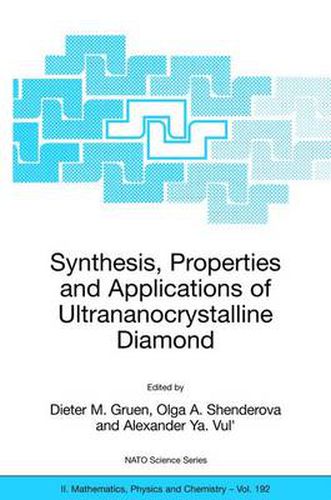Readings Newsletter
Become a Readings Member to make your shopping experience even easier.
Sign in or sign up for free!
You’re not far away from qualifying for FREE standard shipping within Australia
You’ve qualified for FREE standard shipping within Australia
The cart is loading…






This title is printed to order. This book may have been self-published. If so, we cannot guarantee the quality of the content. In the main most books will have gone through the editing process however some may not. We therefore suggest that you be aware of this before ordering this book. If in doubt check either the author or publisher’s details as we are unable to accept any returns unless they are faulty. Please contact us if you have any questions.
We are pleased to present the Proceedings of the NATO Advanced Research Workshop Syntheses, Properties and Applications of Ultrananocrystalline Diamond which was held June 7-10, 2004 in St. Petersburg, Russia. The main goal of the Workshop was to provide a forum for the intensive exchange of opinions between scientists from Russia and NATO countries in order to give additional impetus to the development of the science and applications of a new carbon nanostructure, called ultrananocrystalline diamond (UNCD) composed of 2-5 nm crystallites. There are two forms of UNCD, dispersed particles and films. The two communities of researchers working on these two forms of UNCD have hitherto lacked a common forum in which to explore areas of scientific and technological overlap. As a consequence, the two fields have up to now developed independently of each other. The time had clearly come to remedy this situation in order to be able to take full advantage of the enormous potential for societal benefits to be derived from exploiting the synergistic relationships between UNCD dispersed particulates and UNCD films. The NATO sponsored ARW therefore occurred in a very timely manner and was successful in beginning the desired dialogue, a precondition for making progress toward the above stated goal. The discovery of UNCD completes a triadof nanostructured carbonswhich includes fullerenes and nanotubes.
$9.00 standard shipping within Australia
FREE standard shipping within Australia for orders over $100.00
Express & International shipping calculated at checkout
This title is printed to order. This book may have been self-published. If so, we cannot guarantee the quality of the content. In the main most books will have gone through the editing process however some may not. We therefore suggest that you be aware of this before ordering this book. If in doubt check either the author or publisher’s details as we are unable to accept any returns unless they are faulty. Please contact us if you have any questions.
We are pleased to present the Proceedings of the NATO Advanced Research Workshop Syntheses, Properties and Applications of Ultrananocrystalline Diamond which was held June 7-10, 2004 in St. Petersburg, Russia. The main goal of the Workshop was to provide a forum for the intensive exchange of opinions between scientists from Russia and NATO countries in order to give additional impetus to the development of the science and applications of a new carbon nanostructure, called ultrananocrystalline diamond (UNCD) composed of 2-5 nm crystallites. There are two forms of UNCD, dispersed particles and films. The two communities of researchers working on these two forms of UNCD have hitherto lacked a common forum in which to explore areas of scientific and technological overlap. As a consequence, the two fields have up to now developed independently of each other. The time had clearly come to remedy this situation in order to be able to take full advantage of the enormous potential for societal benefits to be derived from exploiting the synergistic relationships between UNCD dispersed particulates and UNCD films. The NATO sponsored ARW therefore occurred in a very timely manner and was successful in beginning the desired dialogue, a precondition for making progress toward the above stated goal. The discovery of UNCD completes a triadof nanostructured carbonswhich includes fullerenes and nanotubes.